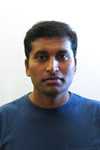Maybe it was the wonky sentence, or Anant's voice.. I started paying attention. Nischal repeated his argument a couple more times, and then ran up to me. Anant and the other troops also followed.
"Pappa, isn't our ancestor a temple?" - his eyes full of confidence.
"Our ancestor is in a temple," I corrected " there's a small temple built for him inside a big temple, and his statue is in it". Since the keywords existed, that was enough for Nischal. Not so for his cohort. A noisy 'is a temple' vs 'in a temple' argument broke out until I convinced them to go chase a football instead.
Months passed, and it was early October. Dasara dolls had taken over my facebook feeds. My better half wasn't satisfied with draping just herself with silk sarees this time. She wanted to drape one around 'Smashaan Kaali'. The 'Smashaan Kali' or 'Kali of the cremation ground' temple is at Gokarna, our village on the Arabian sea coast. Only our extended family men have been priests here for as long as anybody remembers. Truth be told, my wife has been talking about draping Kali for many years now. So, we made the trip.
Gokarna is a temple town - Shiva, Kali and Ganesha being the main deities. There's also a Vishnu temple tucked in that I've gone to once in my 4 decades of existence. The 'Smashaan Kali' is at the end of the village - almost at the sea shore. The ground around is sandy and you can hear the sea. The sea breeze ruffles your hair as you walk past burning embers of a recently burnt body to see the goddess within. The goddess is surprisingly small in size, but fierce looking with good detail. For reasons I quite don't fathom, my wife finds her 'so cute'. I'm sure Kali would beg to differ, if she could chime in.
The main Kali temple is at the entrance of the village, and is called 'Bhadra Kali' - the guarding deity of the village. In those premises, in a small enclosure, stands a little statue of 'Jatga'(ಜಟಗ ) - pronounced 'JutGaa'. Our ancestral home is a few hundred feet from the Bhadra Kali temple.
As a kid, I spent many summers there, and my granny Kalyanamma had an evening ritual. Freshly bathed and in fresh saree worn traditional style, her eyes looking large & innocent in high-power spectacles, hands shaking and carefully preparing wicks and oil lamps. We kids would sometimes help her - I can still smell the oil and wick, and hear her clinking bangles. We also went with her to the Bhadra Kali temple, and watch her light lamps for Kali and 'Jatga'.
It was only in my teens I learnt that 'Jatga' was our ancestor, and much later I deciphered that to be the proper kannada word - 'Jattiga' ( ಜಟ್ಟಿಗ ) - a word stemming from 'Jatti' (ಜಟ್ಟಿ ) meaning 'Wrestler', 'Strong man' etc.
As a family tradition, 'Jatga' & 'Maasti katte' (more on that later) are remembered in every major festival. Before the ceremonies in the house start, we all visit there, offer flowers, break coconuts, light incense.. the whole pooja ritual. One person takes the role of spokesman, talks about projects/problems any other family members are facing, and asks for blessings. In the family, a visit to the village automatically means a couple of minutes with folded hands and closed eyes in these two places.
The night before our trip back, we decided to visit the Bhadra kali temple. The kids naturally preferred to worship the iPad goddess until I mentioned Mr. Jatga. Soon, the curious cats were walking to the beat of the rain, and the questions started flying.
Nischal: 'Why is Jatga in the temple?'
I : 'Jatga was a strong man who protected the village from attacks. He mostly died protecting the village in a glorious manner'.
Nischal: 'Glorious?'
I : 'I think he killed a lot of attackers, and stopped the attack..'
Nischal: 'How many did he kill?'
I : 'Don't know that, but the point is ... it was a big enough deal that they made a statue of him and put it in the temple'
Nischal was quiet for a while.. probably hearing the sounds of battle. The old rusty sword in the house was probably looking shiny and new in Jatga's hands. After visiting the goddess, we stomped over rainwater puddles to the little temple of Jatga. There was no light inside, and I used the phone's light to show the statue to the kids. They folded their hands and closed their eyes for a couple of minutes before heading back.
'Jatga has a wide nose.. like Ajji (grandma)', said Nischal with a faraway look.
'And a big head - like you' he added after some more observation. I would've given a lot more than a penny to see the movie he was seeing.
'A lot of our relatives have that too..' I remarked .. recalling a linkedin search I'd done a few years ago for the last name and finding many men with big heads and big shoulders. Not a pretty sight by far, but it felt good to feel that Jatga was still part of us. I real
Maybe my imagination, but the kids seemed to be walking straighter as we headed out of the temple.

